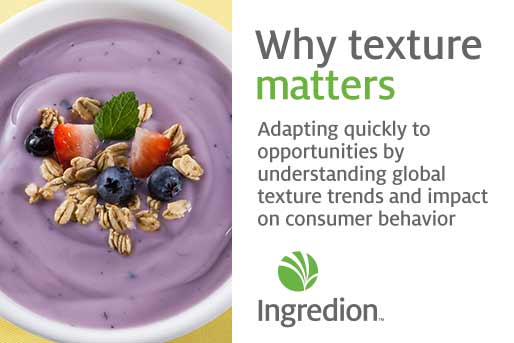As clean label becomes more of a mainstream feature in some countries and segments, the expectations of consumers continue to evolve. In this ever-changing landscape, manufacturers need to innovate to keep up and find new ways to differentiate their products. Ingredion is supporting manufacturers that want to take such actions by researching what consumers want and formulating ingredients that meet these desires.
The evolution of clean label from its beginning as a cutting-edge differentiator to mainstream feature is driven by consumer preferences. A decade ago, food labels frequently listed ingredients that were artificial or unfamiliar to consumers. Over the following years, innovative companies developed new solutions that replaced these materials with familiar household ingredients, enabling manufacturers to improve perceptions of their foods and beverages. Manufacturers of these clean label products gained market share, leading more companies to rethink what goes into their foods.
This story is illustrated by the data. Around four-fifths of consumers think it is important to recognize the ingredients foods contain, according to Ingredion proprietary clean label research released in 2017. In North America, Ingredion’s research also identified that more than 60% of people will pay a premium for products with simple labels.
Knowledge of these preferences has shaped new product launches. From 2012 to 2016, clean label new product launches had a 16% compound annual growth rate, according to Mintel’s Global New Products Database. All applications and geographies contributed to the increase but the move toward clean label happened particularly quickly in certain regions and segments, such as the United Kingdom and ready meals. In these areas, the normalization of clean labels has led to a reduction in the number of related front-of-pack claims.
As this normalisation has unfolded, products in these segments have converged around ingredient solutions that meet the basic demand for recognisable labels and deliver the sensory profile consumers expect. Ingredient lists that until recently set products apart from the competition are now repeated across the industry.
This creates a challenge for manufacturers that previously relied on clean labels to differentiate their products. When clean labels become the norm in a particular category, how can a company stand out from the pack?
What consumers want from food labels
The answer is to dive deeper into consumer perceptions of “healthy” and “natural” to create labels that are even more appealing than those of competitors. As with the creation of the first wave of clean label foods, this entails making labels simpler and choosing ingredients that are considered more healthy and natural than those used in other products.
The difference is it is now far less obvious which ingredients consumers will consider to be healthy and natural. From a clean label perspective, removing polysyllabic chemicals from ingredient lists was a first obvious step for companies that understood its value. Deciding whether consumers will prefer corn starch, potato starch, tapioca flour or rice flour is a considerably harder proposition.
Ingredion, an ingredient provider, is well placed to help manufacturers answer such tough questions. Since 2011, Ingredion has performed several successive waves of consumer research, giving it data on the views of almost 26,000 consumers in 26 countries. These surveys have asked consumers for their opinions on the importance and value of claims, recognition and acceptability of different ingredients and analyzed how the ingredients are perceived from a natural perspective.
The result is a dataset that shows what consumers across the globe want from their food labels. In analyzing this data, Ingredion has identified ways manufacturers can create products that stand out in a sea of competitors with clean labels.
Ingredion’s data points to certain types of flour as being the most widely accepted texturizers. Starch, modified starch and flour can all serve as texturizers in food products. In the past, many products featured modified starches and gums but these fail to support the front-of-pack claims or ingredient listings that consumers increasingly value. Companies replaced modified starches and hydrocolloids with functional native starches, resulting in cleaner labels. However, Ingredion’s research shows these labels can be made cleaner still.
Studies of consumer acceptability show around two-thirds of people would rather see “flour” on a product label than “starch.” This split is fairly consistent across multiple types of flour and starch, including rice, wheat, tapioca, corn and potato.
The finding reflects the widespread belief that flour is “natural” and “healthy.” Many consumers will have a bag of flour in their cupboard. Far fewer will stock anything labelled as starch. In North America, in soups and ready meals the consumer acceptance rates for modified and unmodified starch are 41% and 62%, respectively. The rate for flour is 78%. Consumers in Europe and Asia Pacific express similar preferences for flours over starches.
Ingredion has also explored which types of flour consumers prefer. The details vary somewhat by application and geography but rice flour emerges from the data as a favorite of many consumers. More than 75% of people see rice flour as being natural, healthy and filling in a wide variety of applications, making it slightly more popular than wheat flour. The gluten-free status of rice flour and presence of complex carbohydrates add to the appeal of the texturizer.
These perceptions are fairly consistent across different geographies. Among people in Asia Pacific, rice flour is the best accepted texturizer in yogurts. The difference between the acceptance rate of rice flour and the next most popular flour — tapioca — was 13 percentage points. The same outcome emerged from discussions with North American consumers, who cited rice flour as their preferred texturizer in yogurts, shelf-stable soups and frozen meals.
How consumer research shapes R&D at Ingredion
Ingredion has a long history of applying insights into consumer perceptions to its R&D activities.
Twenty years ago, National Starch, now Ingredion, then one of the world’s main producers of modified starches, developed a proprietary process for producing clean label starches with the function of modified starches. The clean label starches threatened to disrupt Ingredion’s core modified starch business, but the company’s insights into emerging consumer trends showed the need to develop the new product line. The strong shift toward clean label products in recent years has validated that decision.
Since then, Ingredion has continued to develop its technology, enabling it to turn different raw material bases including rice and tapioca into texturizers that have the technical characteristics food manufacturers demand. These activities expanded the range of functional native starches suitable for use as texturizers and thereby enabled development of the first wave of clean label products.
Now, Ingredion has discovered a way to functionalize different types of flour, positioning it to once again disrupt its own business and lead the way in the space. These functionalized flours have the process stability, shelf life and other technical performance characteristics of modified starches, making them ideal for the needs of the food industry. At the same time, the flours meet consumer perceptions of healthy and natural.
Food manufacturers that switch to Ingredion’s flours may further enhance the perception of their labels, distinguishing their products from those using starches as a texturizer. The flours also unlock another differentiator for food companies.
In recent years, the lack of a definition in most countries for what makes a product “natural” has caused manufacturers to be nervous about the use of the word and depressed interest in using it as a differentiator, despite consumers citing it as the most appealing front-of-pack claim. That changed in December 2017 when the International Organization for Standardization (ISO) released a new standard detailing the technical specifications a food ingredient must meet to be classed as “natural.”
ISO’s action is clearly renewing interest in the use of “natural” as a differentiator. Food manufacturers are now comparing their ingredient lists to the technical specifications to assess whether their products comply with the designation. The use of functionalized flours as texturizers can help manufacturers meet ISO’s technical specifications.
Enabling the next generation of clean labels
The journey Ingredion took from being a mainstay of the modified starch industry to being a pioneer of functional native starch underpinned the first wave of clean label new product launches. In developing functionalized flours, Ingredion is continuing this story and laying the groundwork for a second wave of clean label new product launches. Throughout this process, Ingredion has accrued technical knowledge about how to use clean label texturizers in a range of food applications.
Ingredion now has expert application teams focused on dairy, bakery, soups, sauces, ready meals and other applications working out of a network of kitchens and laboratories around the world. The work of these teams is supported by technical and culinary specialists who help customers with day-to-day formulation challenges at a local level, collaborating closely with customer development teams to come up with novel ideas and fast track the progress of new products. This model ensures materials that are suitable for full-scale manufacture are used from early, kitchen-based development onward.
By continuing to perform deep-dive studies of consumer perceptions and adapt its plans to the insights they yield, Ingredion aims to develop a host of new clean and simple solutions to address their needs and those of its customers, ensuring it remains at the forefront of global food trends.




